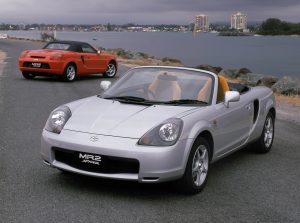Recalls: Toyota ZZW30 MR2
Overview
Manufacturers, or importers, issue recalls for defects or faults which have the potential to cause injury. Generally, manufacturers will inform the original buyers if their vehicle is subject to a recall and of the steps required to remedy the defect or fault. Please note that the recalls below (if any) are for Australian-delivered vehicles only. Furthermore, the number of recalls should not be taken as an indication of a model’s reliability or its safety more generally.
Recalls: Toyota ZZW30 MR2
No recall information is available for the Toyota ZZW30 MR2. To search for recalls of Toyota models, please visit Product Safety Recalls Australia: Toyota.
Problems and faults: Toyota ZZW30 MR2
Overview
This section identifies potential problems, causes and fixes based on the experiences of owners and repairers, online sources and technical service bulletins. This information is provided solely for reference purposes and AustralianCar.Reviews recommends that only properly qualified persons carry out repairs or modifications. Furthermore, the number of items below should not be taken as an indicator of a model’s reliability or the frequency with which they may occur.
To report a problem or fault to the AustralianCar.Reviews team, please use the Contact Us form. Note that AustralianCar.Reviews does not offer advice on automotive problems or disputes; such enquiries will not receive a reply. For vehicles purchased from dealers after 1 January 2011, please see our Australian Consumer Law fact sheet.
Toyota MR2 Spyder: Pre-cat failure
For Toyota ZZW30.I MR2 Spyder vehicles, ceramic pieces of the pre-catalytic converter (‘pre-cat’) can break due to their brittle nature. Ceramic pieces of the pre-cat may enter the main catalytic converter and cause excessive pressure, leading to oil blow-by in the engine. When the VVT-i system operates to achieve exhaust gas recirculation (EGR), the ceramic pieces can be sucked back into the engine, scratching and scoring the cylinder bores, and causing more oil to pass by the piston rings – this blow-by then accelerates the disintegration of the pre-cats. If left unchecked, oil starvation can cause internal components to overheat and destroy the engine. Symptoms of pre-cat failure include oil consumption, a lack of power through the rev range and nosies from the engine bay.
As a result of pre-cat failure, a common modification by owners is to remove the pre-cats.
The Toyota ZZW30.II MR2 Spyder had modified oil rings which prevented oil from leaking past the cylinders and into the pre-cat system. While the oil rings have not been confirmed as the source of the pre-cat failure, it is understood that the ZZW30.II MR2 Spyder does not experience pre-cat failure. For more information about this issue, please see Pre-cats: The Official MR2-ROC Information Thread.
Toyota MR2 Spyder: oxygen sensor failure
The MR2 Spyder has three oxygen sensors, with the O2 sensor fitted after the main catalytic converter susceptible to failure.
Toyota MR2 Spyder: rattling noise
A rattling noise from the MR2 Spyder’s engine bay may be due to loose heat shields.
Toyota MR2 Spyder: exhaust manifold vibration and CCM movement
For early Toyota ZZW30 MR2 models, debris could be sucked into the engine as the exhaust manifold would vibrate and the catalytic converter matrix (CCM) would move within its holding mat during heavy acceleration or braking when the vehicle was cold. From October 2001 (VIN 0043748), improved holding mats and manifolds were fitted.
Toyota ZZW30 MR2: ABS warning light
In 2008, Toyota UK issued a ‘non-code action’ for Toyota MR2 vehicles because the ABS warning light may illuminate because of incorrect fitment of an accessory (NCA/2008/018).
Toyota MR2 Spyder: other problems and faults
- For early Toyota ZZW30 MR2 models, the bonnet could be difficult to raise – this could be fixed by fitting a new bonnet latch and springs.
- If the glass rear screen is broken, the entire roof needs to be replaced.




